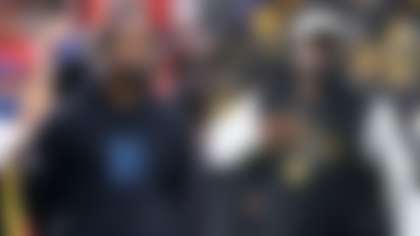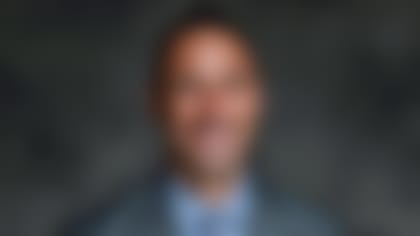Hue Jackson despises the word "rebuild." In his mind, this means taking all available resources and discarding them. A rebuild means burning the forest down. A rebuild means accepting the fact that there will be losses. It means you must inherently trust the architects building the team around you.
Make no mistake, though: The Cleveland Browns are in a rebuild.
Of their two first-round picks from 2014, one is off the roster entirely and the other is already in a make-or-break season. Neither of their two first-round picks from 2015 played more than 550 snaps and both were drafted into schemes that are no longer run by the team.
Their best offensive player, Josh Gordon, still cannot communicate with the coaching staff and front office directly because of his indefinite suspension for violating the league's substance-abuse policy.
Still, Jackson remains relentlessly positive. That is part of the reason the Browns needed him here for the rebuild in the first place.
The other reason is because Jackson is talented. Very talented. Talented enough that Browns fans are clamoring for the team to pick either Carson Wentz, Jared Goff or Paxton Lynch with the No. 2 pick in this month's NFL draft. But that's where they might be wrong. That's where many rebuilds go wrong.
Around The NFL looked back at 10 years of quarterbacks taken in the first round, using several metrics and basic stats to grade the roster strength of the team at the time of each selection. While there are more than a few outliers -- the Panthers pre-Cam Newton, the Giants pre-Eli Manning and the Falcons pre-Matt Ryan stand out -- there seems to be a common thread: In the absence of a truly transcendent, once-every-five-years talent, teams expecting a marked improvement are much better off waiting until their talent level reaches a certain threshold before drafting a quarterback.
Cleveland, by no fault of the current regime, is not close to that threshold.
In fact, the Browns' roster score, which combined the previous year's offensive DVOA rankings from Football Outsiders, the previous year's weighted defense ranking, the previous year's scoring offense ranking and the weighted DVOA of both units, was remarkably similar to another season that might resonate in recent franchise history: 2007 (when the team selected Brady Quinn in the first round). The 2011 team that preceded the drafting of Brandon Weeden actually scored higher. Using a combination of these weighted rankings helps paint a picture as to how capable the roster was. Adjusting for the loss of significant roster changes, the formula is by no means complete and does not account for a change in coaching staff, for example. It does help paint a picture of what is possible with a roster, though.
This piece is not meant to dissuade Jackson and the Browns' front office if they are absolutely blown away by Wentz, Lynch, Goff, Christian Hackenberg or Cardale Jones (nor would it ever have that kind of effect). But at Goff's pro day recently, Jackson noted that everyone was assuming he would draft a quarterback, but that might not be the case -- then he signed Robert Griffin III.
Might he have the same idea? Is he making a big mistake?
Here is a detailed breakdown from our perspective ...
* * * **
The Browns' acquisition of Griffin leads us to believe one of three things:
1) They are not blown away by any of the first-round options at quarterback. (Not true -- they have someone they like, according to a source familiar with the team's plans.)
2) They are blown away, but knowing the pitfalls of starting a rookie quarterback behind this type of roster, they would prefer that person to sit for at least a season behind Griffin while they strengthen it to an adequate threshold. (Potentially true.)
3) They are hedging their bets, and will let the competition solve itself between RGIII and whomever they select at No. 2, understanding full well that the price of quality help is at a premium, and Griffin was worth the $6.75 million just in case. (More than likely true, especially if the team does not get a sexy offer to trade down in the draft.)
The scary part about waiting, of course, is the fear of missing out and the fear that once they do get around to picking a quarterback, he will be nowhere near as good as a quarterback taken at No. 2.
In our rankings, for example, the Jets pre-Sanchez, the Broncos pre-Tebow, the Broncos pre-Cutler and the Buccaneers pre-Freeman all seemed to be in good-to-great shape to draft a quarterback. (The Chargers pre-Rivers and the Packers pre-Rodgers were among the highest scores.) All teams had good or great offenses the year prior, and a good mix of veteran talent on both sides of the ball coupled with young, ascending players. None of those initial four quarterbacks are playing for those teams anymore, even if Tebow did reach the playoffs and Sanchez did make it to back-to-back AFC Championship Games.
Would the Jets -- the team has spent more draft picks on quarterbacks than any other franchise between 1999 and 2015 -- have made it to the Super Bowl with Joe Flacco, whom they passed on in 2008 to draft Vernon Gholston? Would the Broncos have been a more formidable opponent for the Patriots in 2011 with a rookie Andy Dalton or Colin Kaepernick instead of Tim Tebow?
The Browns were one of the teams to appear most frequently on the list of first-round quarterback drafters between 2004 and 2014, and that wasn't even counting the third-round selections of Colt McCoy or Charlie Frye. To say all quarterbacks were the victim of a barebones roster is not accurate, especially because their coaching staffs and executive decision-makers turned over so frequently -- but one often leads to the other.
There is a comfortable notion in the NFL that change to a bad team begins with a new quarterback. A new coach needs his guy. But with the acquisition of chief strategy officer Paul DePodesta and new executive vice president Sashi Brown, the team might examine this vicious cycle more thoroughly. Can a team just not being ready to draft a quarterback?
Here is Cleveland's projected starting offense for the 2016 season -- along with each player's age and 2015 positional ranking from Pro Football Focus:
LT:Joe Thomas, 31, No. 2 overall among right and left tackles.
LG:Joel Bitonio, 24, No. 39 overall among right and left guards (was top five in 2014).
C: Cam Erving, 23, No. 80 overall among right and left guards (drafted as a center).
RG:John Greco, 31, No. 40 overall among right and left guards.
RT:Austin Pasztor, 25, No. 63 overall among right and left guards.
WR:Andrew Hawkins, 30, No. 82 overall among wide receivers.
WR:Brian Hartline, 29, No. 65 overall among wide receivers.
TE:Gary Barnidge, 30, No. 42 overall among tight ends.
RB:Isaiah Crowell, 23, No. 31 overall among running backs.
RB:Duke Johnson, 22, No. 23 overall among running backs.
One would expect Johnson and Crowell to continue to grow. Erving is following a developmental timeline that many interior offensive linemen drafted in the past five years have faced. He has nowhere to go but up, and should improve during his sophomore season. Bitonio had an excellent rookie season that should have merited Pro Bowl consideration, and Thomas is a timeless workhorse at left tackle.
They were also all drafted for another type of offense and contributed to one of the worst attacks in football last season.
* * * **
In a separate data dive, Around The NFL looked at the success rate of first-round picks by position between 2004 to 2014, weighing the 2014 season differently due to a small sample size. For the purpose of the exercise, eventually reaching an All-Pro or Pro Bowl roster was determined a success.
First-round quarterbacks panned out about 42 percent of the time over the last decade, with the Browns going 0-for-3 out of 31 first-round quarterbacks. The highest percentage of hits came at center, tight end, safety, inside linebacker and guard, which are also some of the least-frequently selected positions. (In order for them to get first-round consideration, they are typically exceptional.)
Cleveland's areas of need outside of quarterback are vast: wide receiver, edge rusher, defensive tackle, right guard and offensive tackle, linebacker and cornerback (though the Browns do have some talented but underdeveloped players at that position waiting to be coached up).
So, what does the data suggest they do at No. 2, and what actually might happen?
1) Trade Down and increase the probability of hitting at other positions: This is too easy, right?
We're all Madden Bill Belichicks and are able to churn the No. 2 picks in a ho-hum draft into a wealth of talent. But what's interesting about the Browns is that they also have the No. 32 overall pick thanks to the Patriots' forfeit of their first-round pick, essentially giving them two first-round picks for the third year in a row (and fourth in the last five). The latest quarterbacking rumor mill suggests first-round interest from the Eagles, 49ers, Bears, Rams and possibly Bills. If the Titans are indeed demanding a king's ransom, maybe the Browns are the voice of reason. Falling back to No. 7 or 8 with possibly a first-round pick the following season (not outrageous for followers of the trade-value chart) and a mid-round pick in 2016 still gives Cleveland a shot at some good players who would fulfil a need. It would help them increase their chances of hitting on wide receiver or offensive tackle, both of which should still be available later in the top 10 and into the early second round.
2) Draft Jalen Ramsey if the Titans do not select him No. 1.
Ramsey is being touted as the best defensive back prospect to come out of Florida State since Deion Sanders. According to NFL Media's Albert Breer, there are teams that have Ramsey as the No. 1 safety *and* No. 1 cornerback on their draft board. There is legitimate buzz that he could be drafted No. 1 overall, and he made his case during Florida State's pro day. Ramsey's positional versatility would allow him to grow with the Browns and tap a defensive quarterback of the future. He could fit into multiple schemes and has played nearly every position in the secondary.
Corners and safeties don't get drafted this high because, as Breer notes, they are not always involved in every play like a left tackle or quarterback. However, a look back at every Super Bowl team over the last four years (eight teams) shows a clear-cut dominant corner or safety. The same cannot be said about left tackle, for example.
The success rate of drafting a cornerback is almost equal to that of a quarterback. If we average the success rate of cornerbacks and safeties, though, Ramsey would have a slight edge given that he can easily shift positions.
3) Draft Laremy Tunsil if the Titans do not select him at No. 1.
If we're going purely on odds, this would be the least likely to succeed. An heir apparent to Joe Thomas and a Day 1 starter at right tackle would be nice, but offensive tackles have one of the lowest first-round hit rates according to our calculations (right around 30 percent), and the Browns cannot afford to miss with this pick. There are diverging opinions about Tunsil and how he compares to say, Ronnie Stanley out of Notre Dame. Are they getting an equal talent over the first four years? There aren't many examples of teams stuffing draft assets on their respective offensive lines and making them better. The Browns would have three first-round picks starting at once in 2016 and a second-round pick in Bitonio, who should have gone in the first round.
4) Draft the quarterback
This is why we're here.
The one difference between the Browns' draft failures at quarterback over the past 10 years and now is that they are in a position to actually draft the best quarterback in the lot. This did not happen during the Weeden or Quinn years. They had a chance to take Ben Roethlisberger in 2004, but passed. Not since the Tim Couch selection in 1999 was everything laid completely out on the table. Assuming the Titans do not trade out of the top spot, Cleveland would have its best opportunity for a fresh start since the reincarnation of the franchise.
Maybe that's why people allow themselves to get sentimental and forget that sometimes it is better to have the team built first -- especially when that team is in a no-doubt rebuild. Not asking why can often lead to the same old mess.
Follow Conor Orr on Twitter @ConorOrr.











